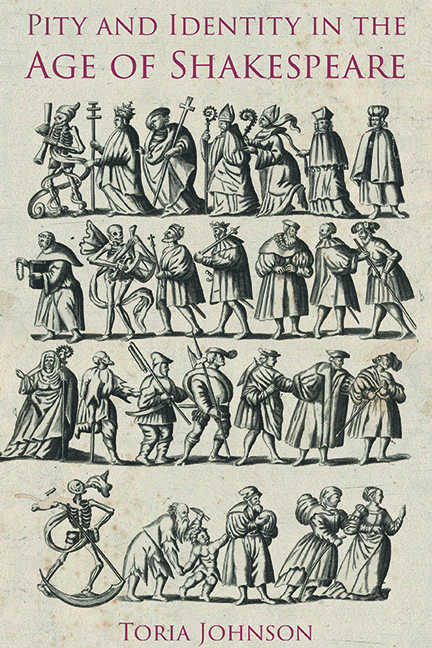Book contents
- Frontmatter
- Dedication
- Contents
- Acknowledgements
- Textual Note
- Introduction
- 1 ‘My name is Pity’: Mediated Emotion and King Lear
- 2 Violent Spectacle and Violent Feeling in Early Modern Lucrece Narratives
- 3 Dramatic Reworkings of Poetic Pity
- 4 Theorising Humanity Through Pity
- Conclusion
- Bibliography
- Index
- Miscellaneous Endmatter
Introduction
Published online by Cambridge University Press: 07 October 2022
- Frontmatter
- Dedication
- Contents
- Acknowledgements
- Textual Note
- Introduction
- 1 ‘My name is Pity’: Mediated Emotion and King Lear
- 2 Violent Spectacle and Violent Feeling in Early Modern Lucrece Narratives
- 3 Dramatic Reworkings of Poetic Pity
- 4 Theorising Humanity Through Pity
- Conclusion
- Bibliography
- Index
- Miscellaneous Endmatter
Summary
The Weakest Creature God Hath Made
Man is the weakest creature God hath made,
For where all else, by heav’nly Providence,
Have bodyes arm’d ‘gainst Foes that them invade,
And rage of Times by Natures muniments,
Man onely Vertue hath for his defence,
This gentle vertue, sweet humanity,
With loving kind and tender heart, from whence
Flow Pitie, Mercy, Love, Benignity,
Whereby we mutuall helpes to others heere supply.
This is a book about the social and emotional vulnerabilities of humankind, and the ways in which early modern English subjects in particular thought about, wrote about, and coped with those vulnerabilities in the context of their own subjectivity. It is about what made them feel weak and emotionally exposed as individuals, how they attempted to manage those weaknesses in social, communal terms, and how literary writing helped them explore, test, and better understand their feelings. It is a central contention of this book that early modern literary depictions of pity – and in particular those written for the early modern stage – bear witness to an impressive range of emotional thinking. I argue that in turning to contemporary literary accounts of pity – many of which explicitly attempt to reconcile the instinct for fellow-feeling with broader notions of personal vulnerability and social obligation – we are able to access a more complex and thorough vision of that period's overarching emotional landscape. That landscape, I suggest, places emotional agency squarely at the intersection of personal subjectivity and social identity. Beyond clarifying a crucial era in a single emotion's history, this way of looking at emotion in print and in practice also opens up important possibilities in the broader field of history of emotions studies.
Both as a concept and as an emotional practice, pity fundamentally influenced early modern subjectivity, defining the boundaries of humanity and individual agency even as it also sometimes eroded them. Published in 1622, the poet Robert Aylett's Peace with her foure garders offers a clear vision of this emotionally inflected subjectivity, in which both emotion and identity are framed in collaborative terms. Aylett describes the human as ‘the weakest creature God hath made’, a being predominantly stripped of physical defences. Whereas he suggests that the rest of God's creatures ‘by heav’nly Providence | Have bodyes arm’d ‘gainst Foes that them invade’, for humankind he sees only one protection: ‘sweet humanity’.
- Type
- Chapter
- Information
- Pity and Identity in the Age of Shakespeare , pp. 1 - 34Publisher: Boydell & BrewerPrint publication year: 2021

